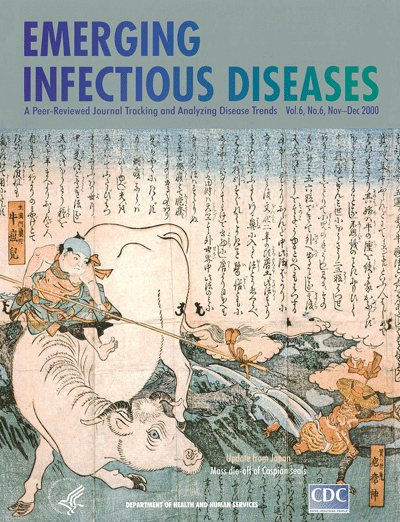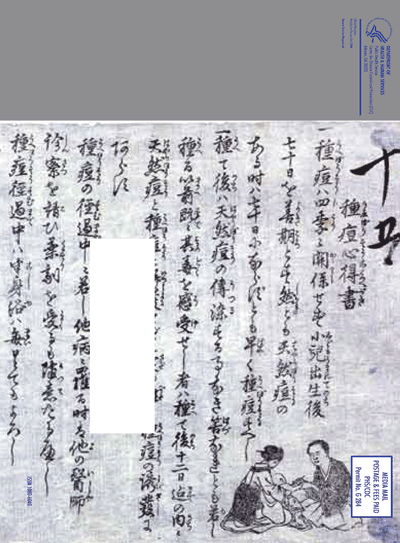ISSN: 1080-6059
Volume 6, Number 6 –Nov–Dec 2000
About the Cover
| Japanese color woodcut print advertising the effectiveness of cowpox vaccine (circa 1850 A.D.) |
Cover text translation by Bonnie Mikami and Masahito Mikami* ![]()
Suggested citation for this article
In 1849, 18 years before the Meiji Revolution, cowpox vaccination was first successful in Nagasaki, which was the only city open to foreign visitors during the Tokunaga Era. This method became widespread throughout Japan. Dr. Ryusai Kuwata (Bunka 8/1811-Keio 4/1868) from Edo (modern Tokyo) made this color woodcut print to advertise the effectiveness of the vaccination to protect against smallpox; he used this picture at the Osaka Vaccination Clinic. The white cow in the print represents vaccination.
It was known that among persons and families who tended cows, the clinical signs of smallpox were never serious. Following this clue, Dr. Kuwata tried vaccinating children with the contents of eruptions from cowpox. As the result, the children's illness was mild and not transmitted to others. Dr. Kuwata, who was the pioneer of vaccination in Japan, vaccinated more than 70,000 people. He died with a vaccination needle in his hand in 1868, when he was 58 years old.
Front cover and text translation

Dr.
Ryusai Kuwata (Bunka 8/1811-Keio 4/1868) . Japanese color
woodcut print advertising the effectiveness of cowpox vaccine
(circa Kaei 3/1850 A.D.)
Reproduced with permission from the Nihon University Medical Library, Iidamachi, Tokyo.
Use of Vaccine Has Spread from Osaka to Edo (Tokyo) for the Benefit of Mankind
I wonder who in the world named Smallpox a God? It is no more than a demon that deviated from the path of mankind.
There are approximately five ways of treating smallpox; one is called the vaccinia method. In the 1790s, a Dutchman [sic] named Edward Jenner announced this method. It is said that when this method was first used, a vaccine made from cow's blood was directly injected into patients. It was quite astonishing that this vaccine, which was made from blood drawn from cow udders and was used on children, cured smallpox.
The first form of this vaccine was the Dutch form, but the Chinese form was used after 1806. The Chinese form is currently being used in Japan, but many forms and methods are used throughout the world. In this manner, vaccination has become a method of treating smallpox.
We began using the Dutch form of the vaccine in the latter half of the 1800s. Thanks to the patronage of our loyal customers, the use of our vaccine has spread widely.
[Translator's note: At the end of this advertisement, there is a poem, the gist of which is, "Parents should do whatever they can to ensure the well-being of their children."]
Back cover and text translation

What You Should Know about Vaccinations
- Babies should be vaccinated on the 70th day after birth, regardless of the season. However, babies may be vaccinated sooner if an outbreak of smallpox has already occurred nearby.
- After receiving the vaccine, patients should not become infected with smallpox, but patients who come into contact with the smallpox virus before being vaccinated should provide a vaccination document that states "smallpox" and "vaccine" to the physician within 10 days after the vaccination.
- If patients become infected with another disease during the vaccination period, they should, at their own responsibility, request to be examined by other physicians and receive medicine for the disease.
- During the vaccination period, a patient may bathe every day in a bath of warm water up to the hips.
- Patients must return to the original medical institution and undergo another examination 8 to 10 days after receiving the vaccination. If a patient fails to receive the second examination, the "vaccination complete" certificate will not be issued.
- A person who has received the "vaccination complete" certificate must be vaccinated again 6 years later and must receive a third vaccination 6 years after that. In either case, the patient must have a physician confirm that the vaccination was successful; provided, however, that if an outbreak of smallpox occurs nearby during that period, another vaccination may be administered before the end of the 6-year period.
Suggested Citation for this Article
Japanese color woodcut print advertising the effectiveness of cowpox vaccine (circa 1850 A.D.) [about the cover]. Emerg Infect Dis [serial on the Internet]. 2000 Dec [date cited]. Available from: http://www.cdc.gov/ncidod/EID/vol6no6/cover.htm
Please use the form below to submit correspondence to the following address:
Polyxeni Potter, EID Journal, Centers for Disease Control and Prevention, 1600 Clifton Rd, Mailstop D61, Atlanta, GA 30333, USA; email: PMP1@cdc.gov
Please contact the EID Editors at eideditor@cdc.gov
The opinions expressed by authors contributing to this journal do not necessarily reflect the opinions of the U.S. Department of Health and Human Services, the Public Health Service, the Centers for Disease Control and Prevention, or the authors' affiliated institutions. Use of trade names is for identification only and does not imply endorsement by any of the groups named above.
This page posted February 26, 2003
Centers for Disease Control and Prevention, 1600 Clifton Rd, Atlanta, GA 30333, U.S.A
Tel: (404) 639-3311 / Public Inquiries: (404) 639-3534 / (800) 311-3435